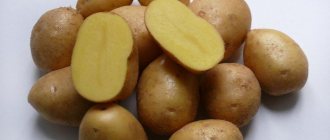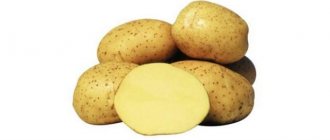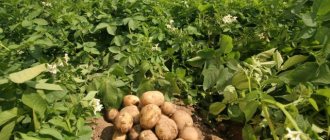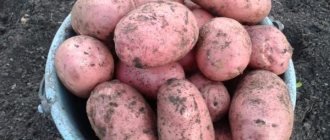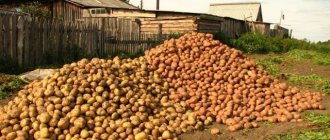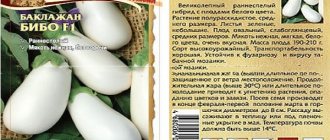Potatoes take pride of place in Russian cuisine. There are hundreds of recipes that use its tubers. Today we will look at mid-early (from 70 to 90 days - ripening period) Elizabeth potatoes, which are classified as table varieties. It is worth noting that due to its high yield and excellent taste, it is a favorite potato among gardeners. Experienced farmers note that Elizaveta is a standard for admirers of the “second bread”, as it belongs to the category of classic varieties.
Potatoes "Elizabeth": variety description, photo
| Variety name | Elizabeth |
| general characteristics | one of the old Russian varieties with good yield |
| Maturation period | 65-80 days |
| 13-14% | |
| Weight of marketable tubers | 80-140 gr |
| Number of tubers in a bush | to 10 |
| Productivity | up to 400 c/ha |
| Consumer qualities | good taste, the flesh does not darken |
| Keeping quality | 93% |
| Peel color | white |
| Flesh color | white |
| Preferred Growing Regions | Northern, Northwestern, Central, Volga-Vyatka, North Caucasus, Far Eastern |
| Disease resistance | moderately susceptible to late blight |
| Features of cultivation | standard agricultural technology |
| Originator | State Scientific Institution Leningrad Research Institute of Agriculture "Belogorka" of the Russian Agricultural Academy together with the "Vsevolozhsk Breeding Station" |
Main features of the variety:
- the tubers are quite large, weighing from 83 to 140 g;
- round-oval shape, with a blunt apex;
- tubers are neat, equal in size and weight;
- the peel is light yellow or cream, evenly colored, moderately smooth;
- the eyes are superficial, small, uncolored, inconspicuous;
- the flesh is white when cut;
- starch content ranges from 13 to 18%;
- tubers are rich in protein, valuable amino acids and vitamins.
The variety "Elizabeth" is presented in these photos:
The potato variety "Elizabeth" belongs to the mid-early, table variety. The yield is good; depending on climatic conditions and soil fertility, it ranges from 290 to 400 centners per hectare. In especially successful years, up to 550 centners can be collected from 1 hectare.
In the table you can see what the yield is for other potato varieties:
| Variety name | Productivity |
| Elizabeth | From 1 hectare they get up to 400 centners. |
| Jewel | From 1 hectare you can collect more than 700 centners. |
| Meteor | 200 – 400 centners per hectare, depending on the region and climate. |
| Forty days | From 1 hectare you can collect from 200 to 300 centners. |
| Minerva | From 200 to 450 centners are collected from 1 hectare. |
| Karatop | You can collect 200-500 quintals per hectare. |
| Veneta | The average figure is 300 centners per hectare. |
| Zhukovsky early | On average 400 centners per hectare. |
| Riviera | From 280 to 450 centners per hectare. |
| Kiranda | From 110 to 320 centners per hectare. |
Harvested potatoes can be stored well for several months without losing their commercial quality. Transportation possible. Large, light-colored tubers with white flesh are ideal for sale.
Read more about the storage time and temperature of potatoes, and about emerging problems. And also about how to do it in winter, on the balcony, in the refrigerator, in drawers, cleaned.
The bushes are compact, low, erect, moderately branched. The formation of green mass is abundant. The leaves are medium-sized, dark green, pubescent, with slightly wavy edges and clearly defined veins. The corolla is white, compact. Flowers are few and fall quickly. The berries do not set.
The root system is well developed. The tubers form together, and at least 10 selected potatoes are formed under each bush. The amount of non-commodity items is minimal.
The variety is undemanding to care and can be planted even by inexperienced gardeners. It is recommended to fertilize with mineral complexes and organic matter, moderate watering and hilling with the formation of high ridges. Use mulching to control weeds.
The first tubers can be dug up in mid-summer, but potatoes reach their maximum yield by the end of the growing season (70-90 days after planting). Seed material is not prone to degeneration and renewal is not required. You can collect potatoes for subsequent plantings yourself.
"Elizabeth" is a variety with good immunity. Potatoes are rarely affected by cancer or common scab; the bushes are resistant to blackleg, golden cyst nematode and a variety of fungal infections. Late blight may affect tops and tubers, Fusarium and Verticillium wilt, and Alternaria blight.
Potatoes have a pleasant, balanced taste, without dryness or excess wateriness. The snow-white flesh does not darken when cut and cooked. Tubers are universal, they can be boiled, fried, stewed, stuffed. Root vegetables make delicious French fries, and you can also make mashed potatoes.
Due to their excellent taste and moderate calorie content, the tubers can be recommended for baby or diet food.
“Elizaveta” is one of the old varieties bred by Russian breeders. Registered in the State Register of the Russian Federation in 1996. Zoned for the Northern, Northwestern, Central, Volga-Vyatka, North Caucasus, Far Eastern regions.
Recommended for cultivation in industrial fields, farms and private farms. The variety is sensitive to soil nutrition and moisture levels.
Characteristics of the Elizabeth variety
Characteristics of a potato variety include the history of origin, the appearance of the bush and tubers, and yield.
Origin story
The Elizaveta variety was developed by Russian breeders in the 90s of the 20th century. Scientists from the Leningrad Scientific Research Institute of Agriculture “Belogorka” worked on it. In 1996, the variety was included in the Russian state register. It is intended for cultivation in the northern regions of the country, and also takes root in the southern regions, where you can harvest a double harvest in 1 season.
External description of the bush
Bush of medium height, erect. Forms long shoots with small leaves. Flowering lasts only 7-10 days. The flowers are purple or white. The root system is strong and promotes good tuber formation.
Productivity and taste properties of root vegetables
Root vegetables have a round or elongated shape, covered with a light yellow peel. The flesh inside is white. The Elizabeth variety is considered a table variety and has a pleasant taste. After cleaning it does not darken or change color. The composition includes 15% starch. Potatoes are low in calories and contain potassium and vitamin C.
Up to 10 tubers are dug from one bush. One potato weighs from 80 to 140 grams. The yield is about 400 tons per hectare of land.
Recommendations for harvesting and storing crops
Harvesting root crops starts 80–90 days after planting. In order for the potatoes to form large fruits, experts recommend cutting off all the tops from the bushes 10 days before harvesting.
Potato digging activities are carried out on a warm, dry day. The harvest is stored in boxes or bags, after allowing the tubers to dry a little under the sun. For storage, it is better to choose cool, dry, well-ventilated rooms with stable temperatures of + 4. + 7 ° C. Potatoes must be regularly inspected for damage, rot, and infected areas. Poor quality root crops should be discarded and destroyed. The variety has good shelf life, and under proper conditions can be stored until the next season, without loss of marketability and taste.
Elizaveta is an unpretentious potato variety that has enjoyed fame and demand among domestic agronomists for decades. It allows, subject to the simplest rules of agricultural technology, to obtain annually consistently high yields of tasty, healthy and aesthetically attractive fruits.
https://sveklon.ru/opisanie-kartofelya-sorta-elizavetahttps://fermoved.ru/kartofel/elizaveta.htmlhttps://fermer.blog/bok/ogorod/kartofel/sorta-kartofelya/sredneranniy-kartofel/3294- kartofel-elizaveta-opisanie-i-harakteristika.html
Care and harvesting
In order for the potatoes to form large tubers, a week before harvesting, you can cut off all the tops from the bushes.
IMPORTANT: Seed material can be selected at the growth stage. For this purpose, bushes are selected in advance.
The irrigation regime is the basis for the formation of a good potato harvest. It is important not to overdo it with water, as its excess can lead to late blight. It is recommended to carry out the first watering at the moment when the bush has risen to a height of 10 centimeters above the ground. During the appearance of inflorescences, the plant needs copious amounts of water. The third time should occur after the disappearance of the inflorescences.
Note!
After this point, it is not recommended to water the potatoes due to the high activity of late blight.
Weeding is a necessary part of properly growing crops. The hilling process will saturate the soil with oxygen and activate the growth of tubers.
Late summer or autumn is a good time to harvest:
- If the tops have already dried out or the skin on the potatoes has become dense, then this is a sign for harvesting.
- First you need to mow all the grass and tops.
- It is recommended to dig up the crop in dry, windless weather using a pitchfork.
- To dry, you need to leave the potatoes in the fresh air for 3-4 hours.
- Tubers must be placed in a ventilated, dark room for one and a half weeks.
After these procedures, pack the potatoes into boxes and bags. Save the strongest fruits for future planting material.
Potatoes of the Elizabeth variety are not picky about storage. But you should monitor the ventilation of the room and temperature conditions. The norm for storage is 1-5 degrees. Potatoes need to be sorted periodically to avoid rotting.
The Elizabeth potato, despite its ancient origin, is still considered one of the most favorite varieties for cultivation among domestic gardeners.
Its root vegetables have dazzling white flesh, excellent taste and an aesthetically attractive presentation.
What are the features of agricultural technology for growing vegetables, and how to properly care for them, let's figure it out.
The Elizaveta variety is a long-standing representative of Russian selection, bred by scientists of the Leningrad Scientific Research Institute together with employees of the Volzhsk Breeding Station. The biological basis of this seven-species hybrid was S.vernei, S.phureja, S.
acaule, S.demissum, S. stoloniferum, S.andigenum and S.tuberosum cultivar.
In 1996, potatoes were included in the state register of Russia as a mid-early table vegetable, recommended for cultivation in the Northern, Central, Western regions, the North Caucasus and Far Eastern regions of the state.
Liza potatoes are a table variety with an average growing season, the fruits of which are ready for harvest 80–90 days after planting.
During ripening, the plant forms erect, low-branched, medium-sized, neat bushes, on which abundant greenery grows in the form of rather large, slightly dissected green leaves with a wavy edge.
During the flowering period, the crop produces a small number of white flowers, which quickly fall off and do not form berries.
The presence of starch varies between 13–18%.{amp}lt;p{amp}gt;
The tubers have an excellent presentation, so they are often used for sale on an industrial scale. Potatoes have a high shelf life, are easily transported, do not rot, and are able to retain their aesthetic and taste qualities until next spring.
The yield of the variety is quite high; on average, 150–400 centners can be obtained from one hectare. Under favorable climate conditions, potatoes can produce a yield of up to 500 centners. Under one bush, up to 10 selected tubers ripen per season, while the number of small, substandard fruits is minimal.
Queen Elizabeth does not degenerate, does not require updating, and the material for planting can be prepared independently.
- Elizabeth potatoes are characterized by a number of key advantages:
- good yield indicators;
- excellent marketability and taste of fruits;
- excellent shelf life and transportability;
- simplicity and undemanding cultivation;
- good immunity to many diseases that affect potatoes.
As experienced farmers note, the variety is practically free of disadvantages. Some difficulties in growing may arise under unfavorable environmental conditions, when the main points of caring for the plant were missed.
Planting potatoes
It is possible to achieve good potato fertility if you take into account the main rules of agricultural technology for planting root crops.
Soil requirements
Activities for planting tubers begin in the second half of May, when the soil warms up well to a depth of 10 cm, and daily temperatures remain at a stable level of 15°C.
Important! Potatoes are resistant to slight cold snaps, but severe or prolonged frosts will be detrimental to them.
Despite the fact that the variety is not too demanding on planting conditions, it prefers light, cultivated, woody-podzolic, sandy loam soils.
Important
Planting the crop on clayey and heavy soils is allowed, however, in such cases it is recommended to enrich and lighten the soil by adding sand, peat, compost, humus or wood ash.
To prevent the development of various ailments and pests, the soil is treated with special disinfectant compounds.
Before planting potatoes, care should be taken to prepare the planting material. It is recommended to germinate and disinfect the tubers. In the first case, the fruits must be placed in a warm place several days (7–10) before planting and wait until sprouts 3-4 cm long appear.
In the second case, the root vegetables should be treated with special preparations or soaked for 30 minutes in a weak solution of potassium permanganate and dried. This treatment will protect the crop from pests and increase the plant’s immunity to various diseases.
Medium-sized tubers, weighing 80–90 g, without mechanical damage, rot, or signs of disease, are ideal as seed material.
Landing technology
The technology for planting Elizabeth potatoes is practically no different from planting other varieties.
It is based on the following steps:
- use a shovel to dig holes at a distance of about 35–40 cm from each other;
- add fertilizers, for example, humus and wood ash, into each cavity;
- Place the tubers with the sprouts facing up in the hole;
- Cover the planted root crops with soil.
When planting fruits, the distance between the rows should be at least 70 cm. Important! It is not recommended to cut the seed material in half, as this leads to a decrease in yield.
One of the main advantages of the variety is its unpretentiousness in cultivation. However, to obtain abundant harvests, it should be provided with traditional care, which consists of regular moistening, fertilizing, loosening the soil, and hilling.
Weed removal
The basic rules of agricultural technology for plant care require the mandatory implementation of a number of activities that contribute to the full development of the crop and high yields:
- Loosening. After each watering, the procedure for loosening the soil should be carried out, going deeper by 3-4 cm. This procedure allows you to saturate the soil with oxygen and nutritional components, thereby activating the development of tubers.
- Hilling. Hilling up is considered a mandatory measure when caring for vegetables, which must be carried out three times during the season: when the shoots reach a height of 8–10 cm, then two weeks after the first and the last when the stem height reaches 20–25 cm. When carrying out activities, it is recommended to monitor so that the widest and highest ridge is formed.
- Weeding. Regularly, as necessary, weeds should be removed from the soil, which take away nutrients and moisture from the root system of the plant. It is especially important to weed before the weeds bloom.
- Mulching. Laying a layer of natural mulch on the soil helps prevent moisture evaporation and create favorable conditions for the development of root crops. For mulching, you can use straw, hay, sawdust or mown grass located between the rows of potatoes.
Elizabeth prefers regular but dosed watering. It reacts equally negatively to both excessive moisture and lack of moisture. The first irrigation measures are carried out immediately after planting root crops.
The second watering is carried out when the sprouts reach a height of 5–10 cm.
Further, the amount of moisture will depend on weather conditions: in hot, dry weather it is recommended to water the bushes every 5 days, in normal temperatures - once every 10 days.
For hydration, settled, non-cold water is suitable, at least 10–12 liters per plant. In order for the crop to receive the required amount of moisture, it is recommended to organize drip irrigation, which will allow the root system to develop correctly and fully.
Important! If there is excessive moisture, the soil near the bushes can be sprinkled with wood ash.
Potatoes respond well to fertilizing, so throughout the growing season, fertilizers should be applied at least three times: the first - during planting of potatoes, the second - before the first hilling, the third - in the flowering phase.
As a top dressing, you can use organic products, for example, humus, manure or compost, as well as ready-made mineral complexes.
10 days before harvesting, it is recommended to perform a single foliar feeding of potatoes using a superphosphate solution that is sprayed on the greens.
The Elizabeth variety has a fairly strong immune system and is able to resist various ailments, in particular scab, potato cancer, blackleg and nematode.
Potatoes "Elizabeth" - description of the variety
It is difficult to overestimate the importance of potatoes on our table. Since ancient times, this traditional vegetable has been consumed both on weekdays and on holidays. And now we cannot imagine our diet without this wonderful nourishing product. Different varieties of potatoes are suitable for preparing different dishes.
So, in order for fried potatoes to be crispy and not steamed, you need to choose varieties that contain little starch. And vice versa - to get delicious airy mashed potatoes, you need to take potatoes with a high starch content for cooking. It cooks much faster and is very crumbly, which is what is required for mashed potatoes.
There are varieties of potatoes that combine good taste and shelf life, and store well until the next season. One of these varieties is the “Elizabeth” potato variety.
Potatoes "Elizabeth" - characteristics
This variety is one of the first potato varieties bred by domestic breeders. Despite the fact that many different varieties were discovered after it, the “Elizabeth” potato variety is still a welcome guest on our table. The Vsevolozhsk Breeding Station and the Leningrad Research Institute “Belogorka” jointly developed the “Elizaveta” potato variety with excellent consumer characteristics.
The "Elizabeth" bush is small compared to its counterparts. The leaves are large, rich green. The variety blooms reluctantly with the ovary falling off and does not form seed peas.
The tubers are round in shape, some slightly flattened, the skin color is from yellowish to light beige. The surface of the tuber is smooth, without roughness, with barely visible eyes. The pulp is white; when processed after cleaning, it is not subject to darkening upon contact with air.
The “Elizabeth” variety is very prolific - in one bush there are about ten large tubers, and from a hectare, with proper agricultural technology, four hundred centners of potatoes are harvested. Excellent taste, average starch content, excellent preservation until a new harvest without loss - all this cannot but please the common consumer who wants to grow a tasty and high-yielding product on his plot. An important advantage of “Elizabeth” is considered to be greater resistance to all types of potato diseases, with the exception of late blight – resistance to it is average.
Today, the planting material “Elizabeth 1” is presented on the market, which is genetically modified. If you are not afraid of experiments, then by purchasing these potatoes, the Colorado potato beetle and diseases are not scary, and a large harvest is guaranteed. But those who do not want to risk their health should choose the old and time-tested variety “Elizabeth”.
| What gardener doesn’t dream of getting bigger and bigger harvests every year? Naturally, everyone. But, if you fertilize the soil, then with what exactly? After all, the agricultural market offers a lot of chemical fertilizers. Therefore, learn from our article about the use of natural fertilizer, urea. | How to plant strawberries in the fall? How nice it is to receive such a tasty delicacy from your own garden, while knowing that the strawberries were grown without the various uses of chemical fertilizers. But there are many secrets in how to properly plant strawberries in the fall. Experienced gardeners will share them with you in our article. |
| Fertilizing strawberries after harvest Strawberry bushes produce a tasty, sweet harvest, soaked in the rays of the summer sun. But after this they need to be fed in order to get even more fruits next season. Find out about all the nuances of such feeding from our new article. | Planting red currants in autumn It's autumn outside the window. And this suggests that it’s time to start planting red currants in order to get tasty, tart-sweet berries next year. Read our article about how to do this correctly. |
Plant care rules
This type of potato is very popular, and these qualities are largely due to its unpretentiousness. To ensure you get a good harvest, you need to follow the basic processes.
- Be sure to loosen the soil to a depth of 3.5-4.0 cm.
- In addition, loosening is carried out after watering and rain.
- The plant is fed several times during the growth period. This is necessary to improve the fruit, and is also useful if the cold returns unexpectedly.
- Fertilizers should include superphosphates, potassium sulfate and Effekton fertilizers.
- During the period of maturation and growth, the plant is positively affected by weeding and watering with a special product “Semetsvetik”, which contains useful substances.
Plant leaves are examined from time to time, as pests may appear. For prevention, gardeners spray potatoes with a chemical. It will protect her from many diseases and parasites.
Advantages and disadvantages of Elizabeth
Elizabeth is one of those varieties that have virtually no disadvantages. The only thing that can spoil the impression of potatoes is their low yield. But again, this can be encountered either by those gardeners who did not care for the crop at all or by those who grew the variety in unfavorable climatic conditions.
Speaking about the advantages, they are as follows:
- Excellent taste and versatility of tubers.
- The variety is quickly sold out on the market, as it has a good presentation.
- Quite strong immunity, protecting the variety, in particular, from potato cancer.
- High shelf life – up to 93%.
- High yield (subject to good care).
Potato variety "Elizabeth" - description and tips for growing root crops
Elizabeth potatoes are included in the list of old well-known varieties that are highly valued by gardeners and farmers. Its popularity is due to its taste and versatility: potatoes are suitable for both sale and consumption. The variety is high-yielding, immune to infections, and has other useful qualities.
Origin
Elizabeth was taken to Russia. It was included in the State Register in 1996. It can grow successfully in the north, northwest, and central part of the country.
Experts recommend growing this variety in industrial fields, farms, and subsidiary plots.
Description and characteristics
So, how does Elizabeth differ from other varieties of culture? Let's list these qualities:
- large tubers weighing 83-140 g;
- round-oval shape of root crops, rounded top;
- neat potatoes of approximately equal size and weight;
- the peel is light yellow or cream-colored, evenly colored, fairly smooth;
- superficial small, barely noticeable eyes;
- white flesh when cut;
- percentage of starch from 13 to 18%;
- proteins, beneficial amino acids and vitamins in root vegetables
The variety is a medium table variety. Gives a high-quality harvest, depending on the climate in a particular area and soil fertility. This figure ranges from 290 to 400 c. with hectares During harvest seasons, 550 quintals are also collected.
Potatoes Elizabeth are ideally suited for sale.
The bushes of the plant are neat, erect, not very branched. The leaves are dense, small, dark green, have wavy edges and clearly visible veins. There are few flowers, they immediately fall off. Berries are not formed.
The roots are well formed.
Tuberization is uniform, each plant produces 10 high-quality root crops. There are very few non-commodity items.
The variety is unpretentious, even novice gardeners can grow it.
The first tubers are dug up in July, but the vegetable produces its largest harvest at the end of the growing season, which lasts 70-90 days. Planting material does not degenerate and does not need to be renewed. You can remove the tubers yourself for the next planting.
The tubers have a balanced flavor, they are dry and do not contain excess water. The color of the pulp does not change during cooking. Potatoes are used everywhere: for frying, stewing, stuffing, mashing and deep-frying.
The variety is included in diets and baby food, as it is low-calorie and tasty.
Advantages and disadvantages
The Elizabeth variety is valued for:
- good yield;
- universal use of root vegetables;
- high marketability;
- long shelf life;
- immunity to major illnesses
There were no obvious disadvantages of potatoes.
How to grow properly
Potatoes should be planted at the end of May, when the soil is sufficiently warm. The variety is resistant to slight cooling, but not to frost. The seeds are pickled, the soil is loosened well, and then disinfected.
Potatoes of this variety need light, semi-sandy soil. You can add nutrients to it using humus and wood ash, which are placed in the holes.
Root crops are placed at a distance of 35 cm from each other and slightly buried, by 10 cm.
The nutritional value of the soil is extremely important for the variety. Therefore, it is fed with potassium-magnesium complexes 2-3 times a season. These fertilizers alternate with organic matter. For example, mullein.
To keep the soil properly moistened, drip irrigation is used. Then the potatoes are not afraid of drought. If, on the contrary, there is too much water, sprinkling with wood ash will help. You can mulch the ground between the rows with straw or grass.
The crop also needs hilling and the formation of large ridges.
Diseases and harmful insects
The immunity of Elizabeth potatoes is quite high. The variety is not affected by scab and cancer, blackleg, cyst nematode and fungus. However, the plant loves late blight of tubers and tops, fusarium, and alternaria.
Under unfavorable conditions, the variety is affected by late blight. For preventive purposes, planting material is pickled and treated with compounds containing copper.
Insecticides save you from Colorado beetles, aphids and thrips. Disinfecting compounds or planting annually in different places help to cope with wireworms.
Colette potato characteristics
Potatoes of the Colette variety have proven themselves well in the middle zone. It is grown by both professional farmers and owners of summer cottages.
The main reasons why the Colette variety is in high demand among potato growers.
- Early ripening. As a rule, in the middle zone, harvesting begins 75-90 days after germination. In the southern regions it is possible to grow in two stages.
- Attractive appearance. The tubers have a regular rounded-elongated shape. The peel is smooth, light yellow or golden in color. Thin. The eyes are weakly expressed.
- Excellent taste. The pulp is light yellow in color and contains up to 15% starch. Therefore, it does not boil over and at the same time does not darken during heat treatment. Suitable for making chips.
- High yield. Forms from six to ten tubers on one bush. Average weight – from 70 to 120 grams. The total yield is from 160 to 290 centners per hectare.
- Has good keeping quality. Up to 92% of potatoes retain their presentation during long-term storage. Excellent transportability over long distances.
- Resistance to diseases such as cyst nematode and potato canker. May be affected by late blight. But, as a rule, in the middle zone the crop is harvested before the first signs of the disease.
Depending on the region, potatoes are planted from the last ten days of April until the twentieth of May. Potato variety “Colette” – heat-loving
It is important that the soil has time to warm up to 14-18 degrees Celsius. But at the same time it retained sufficient moisture. The best predecessors for potatoes are legumes, perennial or winter cereals.
They increase the looseness of the soil and saturate it with oxygen.
The best predecessors for potatoes are legumes, perennial or winter cereals. They increase the looseness of the soil and saturate it with oxygen.
Before planting, it is recommended to germinate the potatoes or keep them in a warm place until sprouts form. The “Colette” variety is planted in beds to a depth of 8-10 cm. The width between rows is 70-90 cm, the distance between tubers is from 30 to 35 cm.
During the season, in order to increase productivity, the following types of work are carried out.
- Harrowing. After one and a half to two weeks, the area is treated. This will loosen the soil and give oxygen access to the plants. And also outline future ridges.
- Hilling. Two or three times a season. The first hilling is carried out after half of the expected number of seedlings appears. Thus, the ranks are finally formed. It also gives impetus to the development of the root system and protects tender shoots from late frosts. Subsequently, before flowering begins, it is advisable to hill up one or two more times.
- Weeding and watering. Conducted as needed. Of course, it is difficult to provide watering to large areas. But its organization in dry years significantly increases the chance of a good harvest.
- Feeding. A healthy potato bush of the Collete variety has a height of 50-70 cm, strong tops and rich green leaves. If the tops are thin and the leaves begin to lighten, then you should think about adding preparations like “Nitrophoska”.
- Mandatory treatment for the Colorado potato beetle. In damp and cool summers, crops can also be treated against late blight. It is advisable to carry out any treatment before the mass flowering of potatoes begins.
- The signal for harvesting is the wilting and yellowing of the tops. It is recommended to mow it a couple of weeks before the tubers begin to be harvested.
Landing Features
Tubers need to be saved for the winter from the previous harvest.
About 2 weeks before the start of planting, you need to lay them out on a well-lit surface. At intervals of 3 days, moisten the fruits with water and turn them over. After 2 weeks, sprouts about 3 centimeters long should form on the potatoes. Depending on the climate of the region, start planting potatoes in late April or early May. The air should warm up to 15 degrees, and the soil to 10.
Rules:
- For planting, choose a well-lit place, without shade.
- This area should have good access to fresh air.
- Clay and sandy soils are not suitable for potatoes, as they retain water and do not deliver nutrients to the roots of the plant.
- Light and loose soil is a good choice.
It is recommended to fertilize and loosen the soil first. Mineral and organic products can be added. For good formation of tubers, it is necessary to apply fertilizers containing nitrogenous compounds.
Compliance with crop rotation will be a good help for increasing crop yields. It is recommended to plant potatoes in the place where legumes or cabbage previously grew. A year before planting, you can plant oats or rapeseed. These crops will disinfect the future soil and add the necessary nutrients.
When planting, the distance between the bushes is about 25 centimeters, and between the rows of the bed about 50. Place the planting tubers at a depth of 8-10 centimeters. Then the soil must be leveled.
Care
The variety does not like excess or lack of moisture; watering should be moderate. The first procedure is carried out during planting, the second, when green shoots of about 5–10 cm appear above the ground. Next, you should monitor the weather and the condition of the soil; in hot weather, potatoes are watered once every 5 days (up to 12 liters of water per bush), and in normal weather temperature no more than once every 10 days. To prevent moisture from evaporating quickly, the beds are mulched.
During the entire growing season, Elizabeth potatoes need root feeding (2 or 3 sessions), mineral complexes and organic fertilizers - bird droppings or mullein. One-time foliar feeding with a superphosphate solution will be of great benefit; it should be done 2 weeks before harvest.
Maintenance is standard - regular weeding and hilling, the first time when the plants rise 8 cm, the next after 15 days, and the last time when the bushes grow to 20 or 25 cm in height. A high and wide ridge should be formed.
Important! To obtain seed potatoes, 2 or 3 weeks before harvesting, it is necessary to cut off all the tops.
Elizabeth's immunity
The Elizabeth variety has a fairly strong immunity that protects against such misfortunes as:
But at the same time, Elizabeth is not protected from fusarium, alternaria and late blight of tubers.
Alexandra Vladimirovna, Kyiv, 49 years old.
Growing up with Elizabeth left a double impression. On the one hand, the variety is quite good, easy to care for, the harvest is decent, and the tubers are large in size. But for some reason we have 1/6 of the harvest with voids. The tubers are large, but empty inside. Maybe some kind of disease, I don’t know, but this has never happened before with other varieties. They didn’t bother to figure it out, they simply abandoned Elizabeth.
Dmitry Vladimirovich, Voronezh, 54 years old.
We have been raising Elizabeth for quite some time. The variety is good. The tubers are not overcooked and have a sweetish taste. Potatoes do not degenerate, the harvest is stable and always good. The tubers are stored well and do not spoil.
Oleg Vladimirovich, Rostov, 51 years old.
Elizabeth likes it. Not the main variety that we grow, but we always allocate 2-3 rows for Elizabeth. Easy to care for, loves watering. We take good care: we mow the tops before harvesting, water, fertilize, and hill up. There are never any weeds in the garden. We haven’t encountered diseases for 10 years; we’ve learned to protect potatoes from them. Elizabeth's yield is good, the tubers are large. The taste is normal. Of course, it’s far from ideal, but the taste is quite good.
Diseases, pests and ways to combat them
Among the diseases to which the variety is most often susceptible, mosaic and Alternaria take the lead. To combat these fungal diseases, fungicide treatment is used.
It is important to promptly detect the disease and carry out treatment at an early stage.
Among the pests that very often attack this variety, the Colorado potato beetle is the undisputed leader. The fight against it must begin as soon as the first insects appear. They can first be collected by hand. If this method loses its effectiveness, then treatment with special chemicals is used.
Chemical treatment of seed material is also quite often used. By the way, if the seeds were purchased in specialized stores, then they most likely have already been treated with chemicals and will be less susceptible to attacks by the harmful beetle.
The use of fertilizers will help to obtain vigorous shoots and a rich harvest.
Diseases and pests
Despite the strong immunity of the Elizabeth potato to golden cyst nematode, potato cancer and scab, the bushes should be inspected from time to time. The variety has weaknesses; it is susceptible to late blight, macrosporiosis, Alternaria and Fusarium wilt.
Any problem can be solved by timely identification and subsequent treatment of the bushes with fungicides; for each disease, a different drug is most often selected. You should consult with sellers in specialized stores and carefully study the instructions.
If a Colorado potato beetle, aphids or thrips are detected, the plantings should be treated with insecticides. Wireworms will not appear in potato beds if legumes are planted between the rows. In the case when the pest is already on the loose and is spoiling the crop, you can get rid of it by spilling the soil with a solution of potassium permanganate, medium concentration (pink).
After Elizabeth, many varieties with excellent characteristics appeared, however, the hybrid is invariably popular and continues to be grown in private and rural farms. The Elizabeth potato has a reputation for being a tasty variety that produces high yields, regardless of weather conditions.
Plant resistance to pests
Potatoes of this variety have high immunity to various diseases: scab, cancer, nematode and many others.
Resistant to late blight and macrosporiosis on tops and tubers. But with excess moisture, these diseases can overtake the plant. Before planting, it is recommended to treat tubers or bushes with preparations that contain copper. As with other potato varieties, there may be problems in the form of:
- Colorado potato beetles on the surface;
- wireworms underground.
Colorado beetles in small numbers can be removed by hand; if there are a lot of them, the plant can be chemically treated. By digging up the soil and removing the grass, you can get rid of potential pests such as wireworms.
If a crop is infected with rhizoctonia, it is recommended to remove the infected specimens from the site. The fungal disease appears as black spots throughout the plant.
To avoid various diseases and pest attacks, it is recommended to observe crop rotation. It is advisable to choose a new place for the garden bed every year. This will increase productivity and reduce the risk of disease.
Note! When using insecticides against pests, it is worth remembering that treatment cannot be carried out less than 20 days before harvest!
How to care?
For a good potato harvest, you need to perform 5 operations:
- hilling;
- watering;
- loosening;
- weeding;
- fertilizing
Hilling
The “Elizabeth” potato variety is very responsive to hilling; it needs to be done several times a season, at least 2 times, with an interval of 2 weeks.
- With a bush height of 10 cm.
- At a height of 20-25 cm.
When hilling, they try to form a wide and high ridge.
Watering
Potatoes "Elizabeth" are moisture-loving varieties, but do not really like irrigation due to poor resistance to late blight of the tops. It is optimal to use drip irrigation, which is carried out:
- with a tops height of 15-10 cm;
- at the beginning of budding;
- immediately after flowering ends.
In hot weather, water additionally (the variety is not drought-resistant), but not more than once every 5 days.
After watering, the plantings are loosened and mulched with mown grass, straw, humus, and peat.
Loosening and weeding
“Elizabeth” is demanding of moist, breathable soil, so frequent loosening of the ridges is necessary to break up the surface crust.
Mulch around potato bushes solves this problem well. In the absence of a mulch layer, weeding and loosening are carried out at least 2 times per season, combining these operations.
Top dressing
Throughout the growing season, potatoes must be fed.
Organic fertilizers are applied during digging. Root fertilizing with mineral fertilizers is carried out:
- when sprouts appear, with a mixture of NPK 20:10:10;
- at the budding stage, NPK mixture 10:20:10;
- during flowering, composition PK 20:20.
Foliar application - once with a superphosphate solution 2 weeks before harvest.
Attention! Do not use fertilizers containing chlorine.
Disease and pest control
The main thing is to prevent infection, for which the bushes are regularly inspected.
At the first manifestations of diseases, treat the plantings with fungicides in accordance with the instructions. The variety is not resistant to macrosporiosis (“spotted dryness”) and fusarium wilt. The most effective remedies for these infections are spraying with Bordeaux mixture, pink solution of potassium permanganate and garlic infusion.
When Colorado potato beetle larvae appear, they are collected by hand and destroyed, after which the plants are sprayed with insecticides.
To protect against wireworms, legumes and mustard are planted between the rows, and the soil is spilled with a pink solution of potassium permanganate.
To reduce the risk of diseases, it is advisable to change the potato plantation site every 2 years.
The best precursors for potatoes are mustard, legumes and cereals.
How to grow properly
Potatoes should be planted at the end of May, when the soil is sufficiently warm. The variety is resistant to slight cooling, but not to frost. The seeds are pickled, the soil is loosened well, and then disinfected.
Potatoes of this variety need light, semi-sandy soil. You can add nutrients to it using humus and wood ash, which are placed in the holes.
Root crops are placed at a distance of 35 cm from each other and slightly buried, by 10 cm.
The nutritional value of the soil is extremely important for the variety. Therefore, it is fed with potassium-magnesium complexes 2-3 times a season. These fertilizers alternate with organic matter. For example, mullein.
A remedy that makes plants grow by leaps and bounds! Just water your plants with this Read more…
To keep the soil properly moistened, drip irrigation is used. Then the potatoes are not afraid of drought. If, on the contrary, there is too much water, sprinkling with wood ash will help. You can mulch the ground between the rows with straw or grass.
The crop also needs hilling and the formation of large ridges.
To get a good harvest, you need to use high-quality seeds. The most productive varieties are possible. Large selection of varieties for every taste.
How to harvest and store crops
The time for harvesting comes when the tops turn completely yellow and begin to wither. If you delay harvesting, the presentation of the potatoes will be much worse: they will become lumpy and the skin will become rough.
You can harvest either manually or using a walk-behind tractor, since Dutch varieties are resistant to mechanical damage.
They dig Dutchwort only in dry, warm weather. The dug up root vegetables are immediately laid out in a well-ventilated, dry room to dry. Drying time is at least 2 weeks.
Note! To speed up drying, the root vegetables are laid out in one layer. Next you need to sort the potatoes. Sluggish and spoiled fruits are thrown away immediately; they will not be stored
Sluggish and spoiled fruits are thrown away immediately; they will not be stored
Next you need to sort the potatoes. Sluggish and spoiled fruits are thrown away immediately; they will not be stored.
Storage features and keeping quality of the Dutch variety
The shelf life characteristics of this varietal group are high, up to 98%. Store potatoes at a temperature no higher than 3 °C and a humidity of at least 70%.
Planting and growing the Golubizna potato variety
When planting potatoes of this variety, you should not miss the required deadlines, otherwise the shelf life of the product will be reduced. Blueberry gives excellent results even when planted in soil that is not warm enough.
Optimal timing
You can plant Golubizna potatoes in early May, when the soil temperature reaches +7°C. If the weather is particularly warm, planting can be done in April.
Did you know? In 1995, potatoes became the first vegetable to be grown in outer space.
Crop rotation rules
To get a full harvest, you need to follow the rules of crop rotation. Potatoes cannot be planted in the same place for 2 years in a row. Ideally, potatoes can be planted in their former place of growth no earlier than after 3–5 years. However, this method is not suitable for everyone, since most of the site is usually occupied by plants of the Solanaceae family, which cannot be the predecessors and neighbors of potatoes.
You can use a three-field crop rotation system on the site.
With this approach, the area is divided into 3 parts and proceed according to the following scheme:
- In the area intended for potatoes, green manure (winter crops) are planted. Before the first frost, the greens are mowed and the soil is cultivated to a depth of 15 cm.
- In the second plot, cabbage and plants of the Cucurbitaceae family (zucchini, squash, cucumbers, etc.) are planted.
- It is better to use the third plot for legumes. You can also plant radishes, carrots, onions, herbs and beets next to the potatoes.
- From the second year, crops begin to change places in a circle.
There is another system - two-field. In this case, the area is divided into 2 parts. The first is for potatoes, the second is for all other plants. After harvesting the potatoes, green manure is sown in its place and proceed as in point 1 of the three-field scheme.
Soil requirements
The ideal option for growing potatoes is loamy or sandy loam soils. But thanks to the high adaptive abilities of the variety, it bears fruit well on other types of soil.
Soil preparation is carried out in August-September. You should dig up the selected area in advance to a depth of 25 cm, fertilize it with rotted manure - 10 kg for each m². After a week, you need to sow winter crops, mow them before frost and dig up the soil again.
At the end of March - beginning of April, the soil is again cultivated to a depth of 25 cm. Next, superphosphate is added - 500 g/m².
Did you know? Potatoes are used not only for food purposes, but also for the production of glue and ethanol.
Preparation of planting material
Seed potatoes are selected during harvest, setting aside the healthiest and most even medium-sized tubers. They are placed in wooden boxes and sent for storage with the rest of the products.
1.5 months before planting, you can begin to germinate planting material. Seed potatoes are taken out of the cellar to sort through and discard spoiled tubers. Then it is placed in wooden boxes in a single layer and sent to a well-lit room where the air temperature is +18°C and the relative humidity is 40–60%.
After 3 weeks, the surface of the potatoes will acquire a green tint, and sprouts will appear from the eyes. At this stage, they should be moistened with water and covered with film, and left in this form for another 7 days. When the sprouts reach a length of 1–2 cm, the potatoes are ready for planting. At this stage, it is necessary to cull: specimens with too long and thin sprouts are not suitable for planting.
To disinfect fruits, use a 1% solution of copper sulfate. Root crops are sprayed with it a few days before planting.
Find out also how to grow potatoes from seeds at home.
Planting potatoes
It is possible to achieve good potato fertility if you take into account the main rules of agricultural technology for planting root crops.
Soil requirements
Activities for planting tubers begin in the second half of May, when the soil is well warmed up to a depth of 10 cm, and daytime temperatures remain at a stable level of +15°C.
Important! Potatoes are resistant to slight cold snaps, but severe or prolonged frosts will be detrimental to them.
Despite the fact that the variety is not too demanding on planting conditions, it prefers light, cultivated, woody-podzolic, sandy loam soils. Planting the crop on clayey and heavy soils is allowed, however, in such cases it is recommended to enrich and lighten the soil by adding sand, peat, compost, humus or wood ash. To prevent the development of various ailments and pests, the soil is treated with special disinfectant compounds.
Preparation of planting material
Before planting potatoes, care should be taken to prepare the planting material. It is recommended to germinate and disinfect the tubers. In the first case, the fruits should be placed in a warm place several days (7–10) before planting and wait until sprouts 3-4 cm long appear. In the second case, the root crops should be treated with special preparations or soaked for 30 minutes in a weak permanganate solution potassium, dry. This treatment will protect the crop from pests and increase the plant’s immunity to various diseases.
Medium-sized tubers, weighing 80–90 g, without mechanical damage, rot, or signs of disease, are ideal as seed material.
Landing technology
The technology for planting Elizabeth potatoes is practically no different from planting other varieties.
It is based on the following steps:
- use a shovel to dig holes at a distance of about 35–40 cm from each other;
- add fertilizers, for example, humus and wood ash, into each cavity;
- Place the tubers with the sprouts facing up in the hole;
- Cover the planted root crops with soil.
When planting fruits, the distance between rows should be at least 70 cm.
Important! It is not recommended to cut the seed material in half, as this leads to a decrease in yield.
